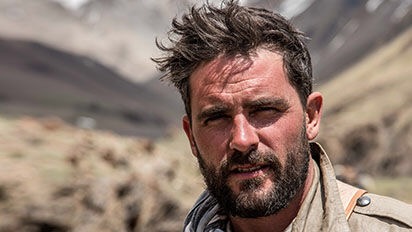Explorer Levison Wood, follows up his 2013 trek along the entire length of the Nile by attempting to walk the entire length of the Himalayas.
Beginning in Afghanistan and trekking 1700 gruelling miles across the roof of the world, Levison will be travelling through some of the most remote, beautiful, and perilous places on earth, teaming up with local guides and meeting soldiers, monks and nomadic tribes as he tries to complete his challenge.
Walking the Himalayas, which will be shown on Channel Four, will see Levison push himself to his physical limits as he is forced through remote, punishing terrain and altitudes above 5000m where he suffers from a debilitating lack of oxygen.
As well as battling natural obstacles, he has to tread carefully through one of the most fought-over areas of the world – walking through Afghanistan, crossing the Line of Control between Pakistan and India, navigating the disputed territory of Kashmir and making his way through Nepal as it recovers and tries to rebuild itself after the recent earthquakes.
The series is adventure journalism at its most raw and authentic, but with that comes danger. Last week, Levison and his friend and guide, Binod Pariyar, were involved in a serious car accident in rural Nepal, when the taxi taking them back to their overnight accommodation crashed off the road, leaving Lev with a severely broken arm..
The two met on Levison’s first trip to Nepal back in 2001, when Binod saved him from the fighting that surrounded that year’s political upheavals, and they were reunited on this journey. Once they’ve recuperated, they plan to resume the walk together.
In a journey of some four million steps, Levison has also had a chance to meet other local people face to face and at their pace. Relying on their hospitality to make it to his next destination has given him a chance to understand the Himalayan way of life as he’s been yak-herding with the Wakhi tribe, played Buzkashi with the Kyrgyz, eaten sheep eyeballs and met blood-drinking shamans, separatist fighters and people rebuilding their lives after natural disasters.
In 2013, Levison Wood walked the Nile from its source to the sea. The documentary series following his trek was a hit with viewers and critics, drawing an average of 2.6m viewers and critical praise including: ‘‘A series as real and raw as the landscape … Genuine jeopardy is what distinguishes Walking the Nile from the more or less bogus adventure programmes that we have come to expect.’ (The Times): ‘An extraordinary piece of television’ (The Evening Standard); ‘Probably the most shocking travel show you will ever see’ (Daily Mail);
Walking the Himalayas, like Walking the Nile, is being filmed by Levison himself, with visits at key points from a television crew for a TV series to be broadcast in early 2016.
Levison Wood said: “After Walking the Nile, I spent a lot of time thinking about “where next” before settling on the Himalayas. It’s an area I’ve had some experience of, from my time in the Army in Afghanistan and leading expeditions in the region. And it’s an area I really wanted to find out more about – following in the footsteps of great explorers and witnessing at first-hand how people survive and prosper in some of the most remote and challenging terrain on earth. It’s going to be incredibly demanding, pushing me to my limits, but incredibly rewarding at the same time.”
John Hay, Commissioning Editor for Channel 4, said: “I thought Lev’s Nile expedition would be hard to top, but having seen the first rushes from this I’m bowled over. He’s already walked through parts of Afghanistan and Northern Pakistan I’d never even heard of before this project began, but which are both utterly spectacular and seriously tough. In our connected age, anyone with money can travel, but to commit to walking every single step through this part of the world takes extraordinary guts and resilience – and there’s no-one I’d rather go on that journey with than Lev.”







